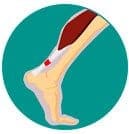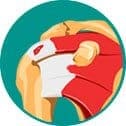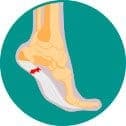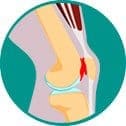Extracorporeal shockwave therapy (ESWT) has been used to treat knee pain, heel pain, Achilles pain, and calcific tendonitis.
Extracorporeal shockwave therapy is a procedure, which stimulates the body’s natural healing process. Shockwave therapy produces micro-trauma in the affected area’s tissues with energy pulses. The body responds to the minute tears caused by extracorporeal shock wave treatment with increased blood flow, delivering nutrients and reducing pain. Sixty-five to 91 percent of patients have experienced successful healing with extracorporeal shock wave therapy.
Initially, ESWT was developed for breaking up kidney stones deep within the body. When extra healing benefits were noticed in kidney stone patients, doctors began using shockwave therapy for heel pain, knee pain, calcific tendinitis, and Achilles pain.
Shockwave therapy for Achilles pain is similar to the treatment for plantar fasciitis, except it focuses on a different area of the foot. The therapy has been successful at repairing degenerative damage caused by repetitive strain on the Achilles. The largest tendon in the body is instrumental to so many strenuous activities, such as jumping and running, that it can often wear down.
ESWT reduces the inflammation these activities cause by strengthening the tendon in much the same way heel pain is treated.
Calcific tendinitis (or tendonitis) forms from small calcium deposits developing within a tendon. The condition often occurs in the rotator cuff of the shoulder. Shockwave therapy for tendinitis is effective at breaking up these deposits and mitigating the irritation they cause.
A study reported in the Journal of Orthopaedics and Traumatology found that ESWT treatment was just as effective as surgery for treating calcific tendonitis. However, shockwave treatment has the benefit of being non-invasive and often requires no anesth
Plantar fasciitis is a painful condition experienced by many people. The condition is often aggravated from long periods of standing or walking, though it can occur without these activities. Heel pain develops when the tendon running from the ball of the foot to the heel becomes inflamed, causing soreness in the arch of the foot. ESWT strengthens the connective tissues reducing the inflammation and pain.
Shockwave therapy for the heel significantly reduces discomfort for most patients with heel spurs as well by breaking up calcium deposits irritating the soft tissues of the foot.
Shockwave therapy for knee pain has also been found to be highly effective. The knee is comprised of numerous connective tissues, which become inflamed and irritated with overuse and overexertion.
According to a study in the North American Journal of Sports Physical Therapy, chronic tendinopathy is a musculoskeletal disorder in the knee common to all levels of athletes. The condition is often referred to as “jumper’s knee,” and is a frequent occurrence for basketball and volleyball players. The knee pain associated with the injury can often be debilitating for weightlifters too.
Methods for treating chronic tendinopathy often include restriction or modification, ice, eccentric stretching, massage or taping. When these management practices have been found ineffective, extracorporeal shock wave treatment has been found highly productive at treating the tendon degenerati






























































